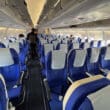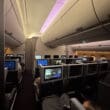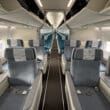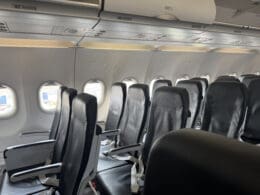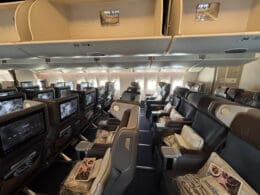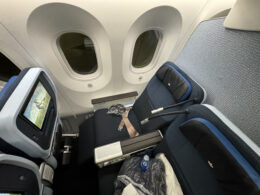Last month Hong Kong Airlines introduced their new A350 business class product, which I had the chance to tour and extensively write about. Hong Kong Airlines’ newest A350s all feature reverse herringbone seats in business class, which Cathay Pacific has operated on a majority of their longhaul fleet since 2011 (including on their A350s, even though they evolved their reverse herringbone seat in 2016). Reverse herringbone seats are my favourite business class configuration out there, due to the smart balance between privacy, comfort, and storage, so you’ll have a comfortable flight either way.
However, as you’d expect, having installed this seat quite late in the game, there are definitely many features to Hong Kong Airlines’ reverse herringbone seat on their newest A350s that differ from what you’d find on Cathay Pacific.

Hong Kong Airlines Airbus A350 Business Class Cabin
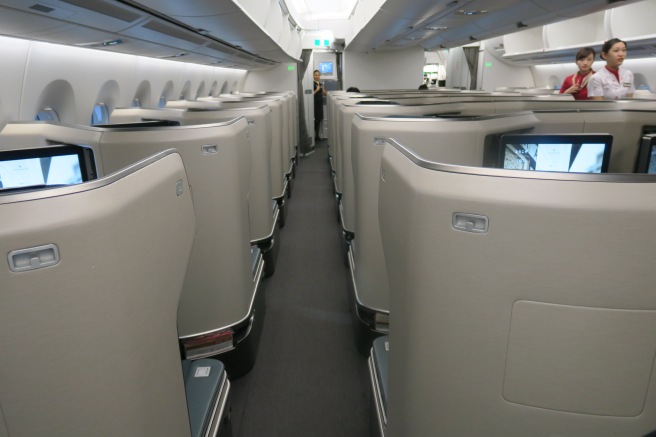
Cathay Pacific Airbus A350 Business Class Cabin
I thought I’d put these two seats head-to-head, and decide which seat is more comfortable for a longhaul flight. Both of these seats will be deployed on flights of over 12 hours, so nuances in seat design can really catapult your experience in a business class product on such a long flight.
Before I get into the nitty-gritty details, here’s my writeup of Hong Kong Airlines’ new A350 business class:
Here are some reviews we’ve written of Cathay Pacific’s A350 business class:
- Cathay Pacific A350 Business Class Zurich to Hong Kong
- Cathay Pacific A350 Business Class Taipei to Hong Kong
- Cathay Pacific A350 Business Class Hong Kong to Newark
Comfort
First let’s talk about the seat as it is. Both seats are relatively well-padded, and have some of the most shoulder space and privacy of any business class seat out there. I really wouldn’t have any qualms sitting, relaxing, or working in either of these seats.
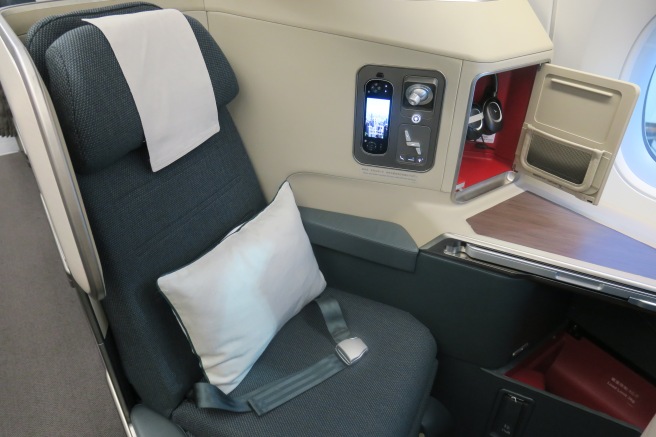
Cathay Pacific Airbus A350 Business Class Seat

Hong Kong Airlines Airbus A350 Business Class Seat
While some might find it hard to look out of the window during takeoff and landing on Cathay Pacific, you can actually move the seat forward by eleven inches. While I’m not sure if you’re actually supposed to or not during takeoff or landing, I’ve never had an issue by doing so.
In the middle seats, this translates to the fact that you can talk to your partner just as easily on Cathay Pacific despite being separated by two large cupboards, since you can both move your seats forward (or backward, if you have an argument – Hong Kong Airlines has a privacy partition for that).
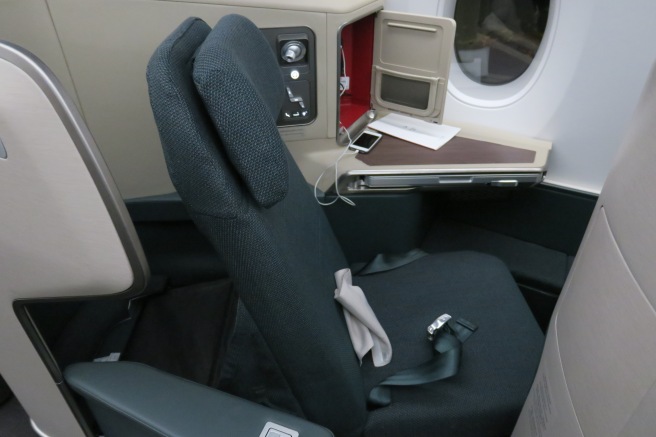
Cathay Pacific Airbus A350 Business Class Seat Forward Position
While I didn’t find this to be a big issue, I do have to say I marginally prefer Cathay Pacific’s version purely in seat mode. This is to do with the headrest, as Hong Kong Airlines’ version juts out more. Ultimately the headrest is plush and acts as a nice pillow on Hong Kong Airlines, though in relax mode it did get in the way. Cathay Pacific’s seat also has a headrest that juts out, it supports the head in a (marginally) more natural position, in my opinion.
Winner: Cathay Pacific
Bed Mode
Now let’s move to one of the most important elements of any longhaul business class seat – bed mode. As both seats are reverse herringbone seats, it goes without saying that you’ll have a very comfortable sleep either way.

Cathay Pacific Airbus A350 Business Class Seat in Bed Position

Hong Kong Airlines Airbus A350 Business Class Bed Mode
While both seats are very wide in bed mode, Cathay Pacific needs to be commended for maximising space unlike any other airline. They custom-designed this version of their seat, and a storage compartment to the side of the seat is integrated into your hip space in bed mode as well. The footwell is also larger on Cathay Pacific than Hong Kong Airlines.
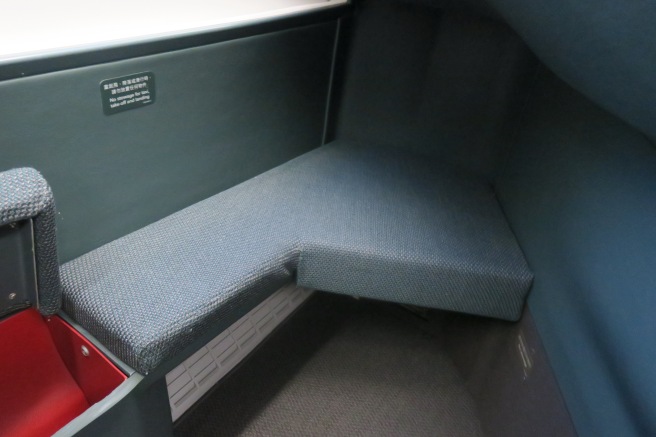
Cathay Pacific Airbus A350 Business Class Footwell
While the footwell on Hong Kong Airlines isn’t as restrictive as it looks, it still has nothing against Cathay Pacific’s version, and you will have problems doing the chicken dance in bed, for example.

Hong Kong Airlines Airbus A350 Business Class Footwell
In addition to the extra foot space, Cathay Pacific also installed a fold-out platform that serves as extra hip space. It’s fiddly to deploy/retract and not especially well-padded, but I do like the addition, which sets it apart from any other reverse herringbone seat, including Hong Kong Airlines’.
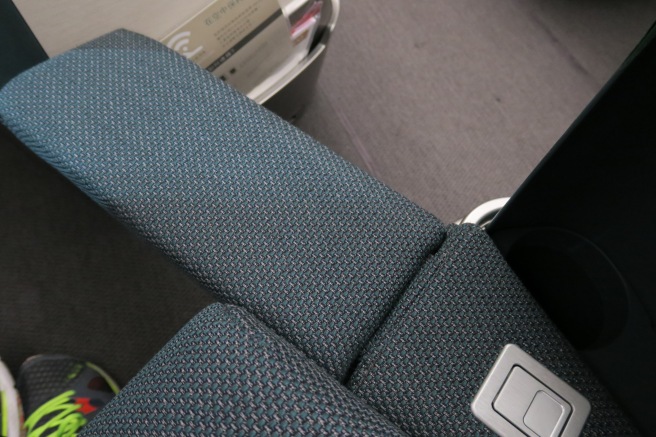
Cathay Pacific Airbus A350 Business Class Bed Extension
Winner: Cathay Pacific
Storage
Here is where the tables turn a little bit. Don’t get me wrong, Cathay Pacific’s seat has a ton of storage space. There’s a storage compartment by the side of the seat, which is handy for personal items, such as a phone.
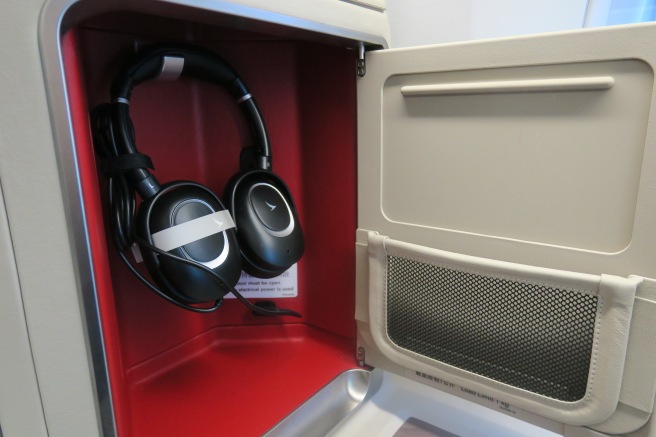
Cathay Pacific Airbus A350 Business Class Cupboard/Headphone Compartment
By the knees is a bigger storage compartment, which is integrated into the bed during bed mode. This storage compartment actually was able to fit my camera bag – no such compartment was able to do so with my experience in Hong Kong Airlines’ business class.
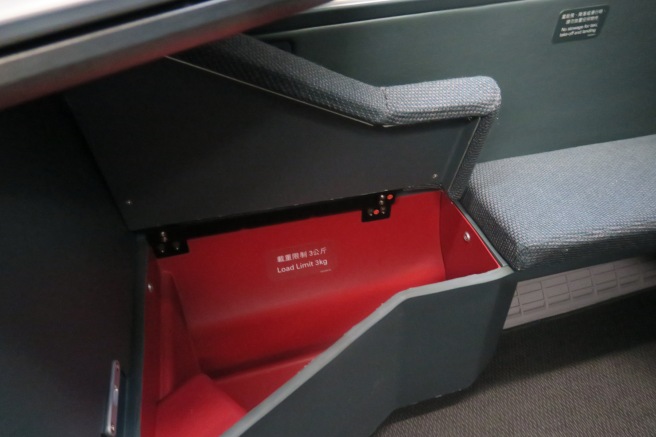
Cathay Pacific Airbus A350 Business Class Side Storage Cupboard
However, Hong Kong Airlines simply features more space for items within reach. It’s much easier to store a phone, a notebook or a pencil case in a cupboard next to you as opposed to in a cupboard or a bigger compartment by your legs.

Hong Kong Airlines Airbus A350 Business Class Storage Area

Hong Kong Airlines Airbus A350 Business Class Storage Area
It’s also worth noting the size difference of the side tables. While dining in a reverse herringbone seat (or any other seat with a large enough side table) I find it convenient to just put my laptop on the side table during meal services, so I can work or edit photos between courses. It’s also handy when doing paperwork on a plane (e.g. filling in landing cards).
Simply put, Hong Kong Airlines’ seat has a much larger side table than Cathay Pacific’s. Much larger.
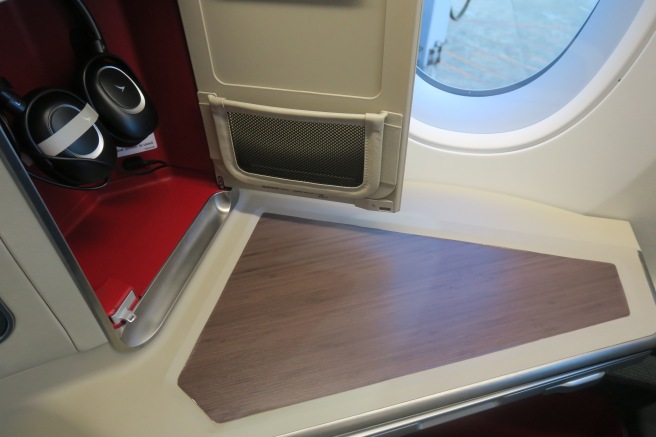
Cathay Pacific Airbus A350 Business Class Side Table

Hong Kong Airlines Airbus A350 Business Class Side Panel
Winner: Hong Kong Airlines
Accessibility
Both seats are smartly engineered so you can leave your seat without retracting your tray table. Cathay Pacific’s tray table slides forward so you can get in and out of your seat, whereas Hong Kong Airlines’ table slides up if you reach below the table and toggle a switch that “unlocks” the table.
While adjusting your table on Cathay Pacific is by far more intuitive, I actually prefer Hong Kong Airlines’ version once you get the hang of it, since the tray table slides up to be level with the rest of the seat. In certain working situations this could be really handy, especially when hosting a last-minute business meeting in the two middle seats. However, that’s my personal preference, and some may prefer the ease of pushing Cathay Pacific’s tray table back and forth when entering and leaving their seat.
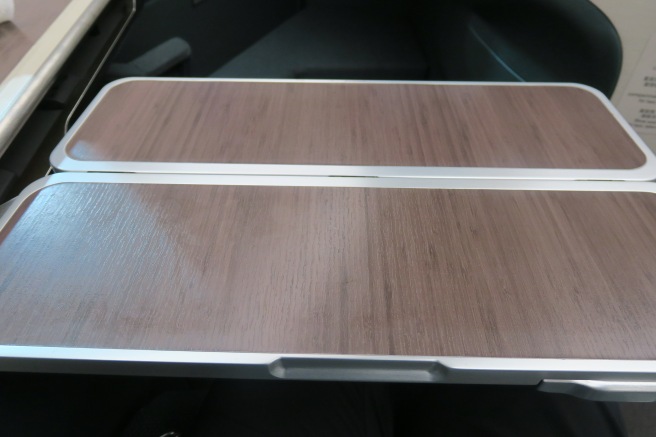
Cathay Pacific Airbus A350 Business Class Tray Table

Hong Kong Airlines Airbus A350 Business Class Tray Table
In addition to this, both seats feature retractable armrests, though I do find Hong Kong Airlines’ version to be a bit fiddlier as well.
Winner: Tie
Other Features
Both seats feature intuitive seat controls, though I prefer the Hong Kong Airlines interface to the clunky Cathay Pacific controls. Hong Kong Airlines also has the added benefit of a preset “relax” position.
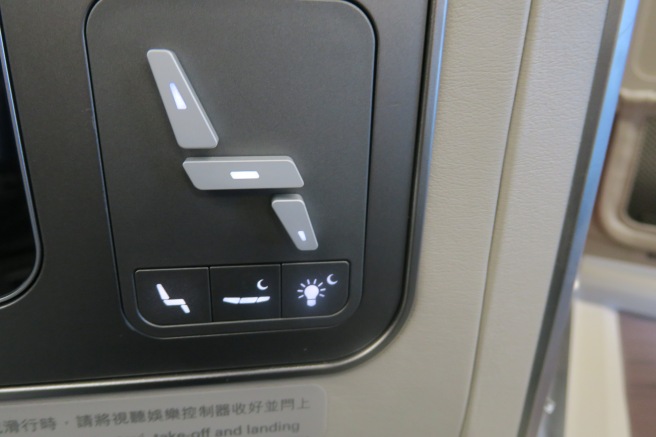
Cathay Pacific Airbus A350 Business Class Seat Controls

Hong Kong Airlines Airbus A350 Business Class Seat Controls
In addition to that, for warmer cabins, Hong Kong Airlines installs air nozzles at all seats on their own A350s (note that their older, leased A350s with staggered seats don’t feature air nozzles, though). Cathay Pacific’s A350s don’t feature air nozzles, though I don’t remember the last time I had an issue with cabin temperature on my many Cathay Pacific flights in the past.

Hong Kong Airlines Airbus A350 Economy Class Air Nozzles (also featured in business class)
It’s still a nice option to have an air nozzle, though.
Winner: Hong Kong Airlines
Bottom Line
In 2016, Cathay Pacific created one of the most practical business class seats out there on their A350. While it was a minor evolution from the 777 and A330 product, there were many touches that set their seat apart from the market, mostly involving the increased bed width. Meanwhile, Hong Kong Airlines went for what is possibly the best “generic” reverse herringbone seat out there on the market.
It’s no question that on a long overnight flight Cathay Pacific beats out Hong Kong Airlines, despite the latter still being very comfortable. However, some of Cathay Pacific’s bed comfort investments came at the opportunity cost of engineering a seat that was better for working, so the storage space and side table area on Cathay Pacific’s A350 shies in comparison to Hong Kong Airlines.
On a longhaul flight (including some of the 13-14 hour jaunts that both seats run on, with some of Cathay Pacific’s being longer) you want the opportunity to sleep and work. I’d say that overall the seats are roughly equal – you can’t go wrong either way. I mean, just to put the competitiveness of both seats into perspective – while Cathay Pacific’s A350 seat might not have as much side storage as on Hong Kong Airlines, you’d still get way more storage space than you would on, say, a business class configuration like Lufthansa’s.WAY more.
It’s worth noting that Cathay Pacific’s A350s all feature this seat, whereas their 777s and A330s feature an inferior, though still really great business class seat. Meanwhile, Hong Kong Airlines only features this seat on their newest A350 as of now, whereas their other A350s and other aircraft feature staggered seats. Their Hong Kong to Auckland route even features an A330 with angled-flat seats right now, whereas Cathay Pacific deploys an A350 on that route. That’s really worth noting if you’re trying to score a business class flight on a Hong Kong Airlines A350 right now. However, in the future, Hong Kong Airlines plans to deliver 16 more A350s with the seat compared above, which will make them really competitive in the long run.
Which reverse herringbone seat do you prefer – Cathay Pacific, or Hong Kong Airlines?

